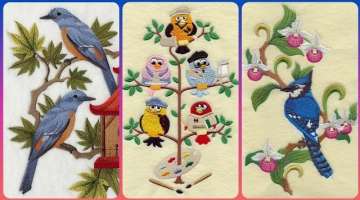Meet The Rufous-Crested Coquette – A Unique Chubby Little Hummingbird (12 Pics)
The world of birds are amazing It has many birds that are too perfect to be true. Some people even think that these flying creatures jump out from fairy books. Not only is their plumage incredibly beautiful but these birds also have one-of-their-kind features. Just look at photos of the rufous-crested croquette below to verify our words.
- 1 | 12

The rufous-crested coquette is tiny and chubby birds like other members of the hummingbird family. But this species makes a name for itself with a brilliant orange crest tipped with black and iridescent green plumage. Introducing the rufous-crested coquette hummingbird, this bird sports a fairytale-esque crown that is like no other.
- 2 | 12

Even within the charismatic hummingbird family (Trochilidae), the tiny, rare, ornately plumaged Rufous-crested Coquette is a standout birders' favorite. The male Rufous-crested Coquette is most easily recognized by its long rufous-orange crest, as well as its green gorget (throat patch) with rufous cheek tufts and white throat feathers, and its conspicuous pale rump-band. The female is similar to the male but has a rufous-orange forecrown without a crest and lacks the male's gorget. Coquettes (of the genus Lophornis) are some of the very smallest members of the hummingbird family and are often described as having a "beelike" flight, with the result that they are sometimes mistaken for flying insects! The Rufous-crested Coquette's breeding and nesting behavior is poorly recorded, other than the courtship behavior of the male involving the display of its crest and short display flights in front of the female.
- 3 | 12

Rare in lowlands of both slopes (a bit more numerous on the Caribbean slope), Rufous-crested Coquettes are more commonly seen in the Panamanian highlands around 900 m (3000 ft). They can be found feeding on flowers located at forest edges, clearings and roadsides, tending to avoid the forest interior. On Canopy Family tours, we most frequently see this species at two regular foothill sites: the Canopy Adventure near the Lodge and Cerro Azul near the Tower. Outside of Panama, this species has a scattered distribution from Colombia south to Bolivia.
- 4 | 12

The green color of its coat comes in different shades. It's darker green on the throat, along with small pointed white feathers. Meanwhile, the belly and back of this hummingbird is a light iridescent green. Like many other species, the female rufous-crested croquette looks duller than the male. She doesn't have green throat and orange crest.
- 5 | 12

This bird is endemic to the tropical slopes of pacific South America. They distribute in the Pacific and Caribbean mountainsides of Peru, Bolivia, Colombia, Ecuador, Panama, and Costa Rica, with at least one sighting in western Brazil. Hummingbirds are solitary in all aspects of life other than breeding; and the male's only involvement in the reproductive process is the actual mating with the female.
- 6 | 12

They neither live nor migrate in flocks; and there is no pair bond for this species. Males court females by flying in a u-shaped pattern in front of them. He will separate from the female immediately after copulation. One male may mate with several females. In all likelihood, the female will also mate with several males. The males do not participate in choosing the nest location, building the nest or raising the chicks.
- 7 | 12

The female Rufous-crested Coquette is responsible for building the cup-shaped nest out of plant fibers woven together and green moss on the outside for camouflage in a protected location in a shrub, bush or tree. She lines the nest with soft plant fibers, animal hair and feather down, and strengthens the structure with spider webbing and other sticky material, giving it an elastic quality to allow it to stretch to double its size as the chicks grow and need more room. The nest is typically found on a low, skinny horizontal branch.
- 8 | 12

The average clutch consists of two white eggs, which she incubates alone, while the male defends his territory and the flowers he feeds on. The young are born blind, immobile and without any down. The female alone protects and feeds the chicks with regurgitated food (mostly partially-digested insects since nectar is an insufficient source of protein for the growing chicks). The female pushes the food down the chicks' throats with her long bill directly into their stomachs.
- 9 | 12

As is the case with other hummingbird species, the chicks are brooded only the first week or two, and left alone even on cooler nights after about 12 days - probably due to the small nest size. The chicks leave the nest when they are about 20 days old.
- 10 | 12

The main diets of these striking hummingbirds are nectar. Their food sources are colored, scented small flowers on trees, herbs, shrubs, and epiphytes. These birds, however, sometimes eat insects and spiders. With this eating habit, the female rufous-crested croquette prefers living in subtropical or tropical lowland and montane forests at altitudes of 500m – 1,900m above sea level.
- 11 | 12

When the breeding season begins, female birds use soft plant fibers, green moss, animal air, and feather-down to build their cup-shaped nest. This nest is placed in bushes, shrubs, or small trees. They then lay 1 egg in their nest and incubate them. The female continues to feed the hatchlings for about 20 days until fully fledged.
- 12 | 12

Can't keep your eyes off these flying gems? Just share this article with your family and friends. They will burst out "wow". Believe us! Take a look at the tail, the rufous-crested coquette has brown, orange, and green feathers on its rump. This feature surely makes it more conspicuous whenever they appear. Let's watch the beauty of this bird in the video below;



















